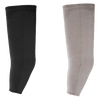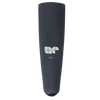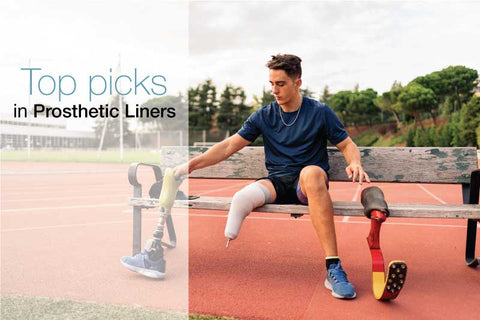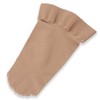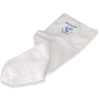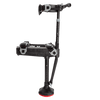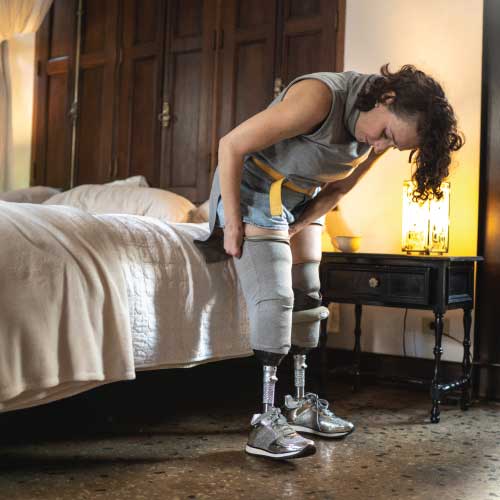New Prosthetic Tech Could Ease Strain on Patients and NHS
Reading Time: 5 minutes
———
In a rush? Read the summary:
Smart prosthetic liners equipped with real-time pressure sensors are set to transform prosthetic care in the UK by reducing socket fit issues and improving patient outcomes. These wearable medical devices align with the NHS Long Term Plan by promoting preventive care, reducing clinical interventions, and lowering prosthetic abandonment rates. Though not yet covered by the NHS, trials are underway to integrate this smart health technology into mainstream care. The impact extends beyond amputees, with potential applications in diabetic care, elder mobility, and sports medicine.
———
The UK’s National Health Service (NHS) faces increasing pressure due to an aging population, financial constraints, rising cost-of-living, and a surge in mental health issues. To tackle these problems, many are turning to the NHS Long Term Plan, a 2019 blueprint that aims to improve patient care, health outcomes, and staff support over the next 10 years. This plan highlights digital technology, preventive care, and community-based services as strategies to ease financial burdens.

Although wearable devices, like smart prosthetic liners, are not yet officially covered by the NHS, there is growing hope that they will be in the future. Ming Kong, co-founder of smart-surface innovator TG0, discussed in Healthcare Today how these smart liners can improve patient outcomes and reduce the need for clinical interventions.
Smart Prosthetic Liners: A Game-Changer for Healthcare
As per Kong, wearable technology is already making significant strides in clinical care. These innovative devices combine advanced features, like real-time data transfer and user-friendly designs, addressing persistent challenges in healthcare. This impact is particularly evident in prosthetics, where a longstanding issue—high prosthetic abandonment rates—has remained largely unresolved.
The core issue lies in poorly fitting prosthetic sockets, which pose a major challenge for lower-limb amputees. According to the MS Society, a poorly fitting socket can lead to painful pressure sores within just 20 minutes, and these injuries often take weeks to heal, resulting in many users opting to abandon their prosthetics altogether. Despite this, the tools available for clinicians and patients to monitor prosthetic fit have been limited, reactive, and often dependent on subjective feedback, Kong said.
Implications of Unaddressed Prosthetic Problems on Costs
Prosthetic abandonment has serious repercussions. For individuals, this translates to decreased mobility, a loss of independence, and a decline in overall quality of life. From a financial perspective, the NHS incurs an estimated annual cost of £10 million due to the need for additional clinical procedures, device replacements, and treatment for pressure-related injuries.
According to Kong, smart wearable technology, such as smart prosthetic liners, can play a crucial role in addressing these challenges. Equipped with ultra-soft, wireless sensors that monitor pressure and comfort levels within the prosthetic socket, smart liners continuously assess pressure points and relay data to a secure cloud platform, which is accessible to both healthcare providers and patients. This allows timely adjustments by the user or in collaboration with a prosthetist, preventing discomfort from escalating into serious injuries.
This cooperative approach ensures that the technology integrates effortlessly into users’ daily routines. As a result, it positively impacts abandonment rates and minimizes secondary complications, such as pressure sores and ulcers.
How This Tech Fits into the NHS’s Long Term Plan
Smart prosthetic liners align seamlessly with the NHS’s overarching digital health strategy, which emphasizes preventive care and community-based management of patient care. By facilitating home-based monitoring and enabling remote input from healthcare professionals, smart prosthetic liners contribute significantly to this vision.
As of this writing, the NHS does not cover smart prosthetic liners. However, British health technology company TG0 is collaborating with the NHS to trial and potentially distribute this innovative solution.
Benefits Beyond Prosthetics
The potential applications of this advanced surface-sensing technology go far beyond prosthetics. Similar sensors show great promise in various areas, including the prevention of diabetic foot ulcers, monitoring posture and weight distribution for wheelchair and bed users, enhancing sports medicine and injury prevention, offering smart insoles for improved gait and alignment, and tracking movement within elder-care environments.
Through remote monitoring and early intervention, Kong emphasized that this technology can help reduce the necessity for specialist consultations, hospital visits, and lengthy recovery times, all while promoting greater patient independence.
What This Means for Amputees in the US
In the US, the implications of implementing this kind of technology are significant. With prosthetic costs ranging from $6,000 to $90,000, depending on the kind and complexity of the limb, any technology that reduces skin issues, clinic visits, or prosthetic rejection can translate into meaningful savings and better outcomes.
But as of this writing, smart liners are classified as experimental or investigational and are not yet covered by insurance.
The Bottom Line
When the NHS decides to include smart liners in its coverage, prosthetic users will see a tangible improvement in their everyday lives. For amputees, having access to this technology means fewer pressure sores, reduced pain, and lower rates of prosthetic abandonment. For busy clinicians, it results in fewer emergency visits and quicker response times.
Related Reading:
The Battle for Mobility: Insurance Denials and Prosthetic Access
$56M Raised to Roll Out Nerve-Stimulation Device for Post-Amputation Pain Relief
Phantom Neuro Secures $19M to Turn Phantom Limb into Movement

